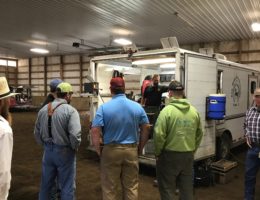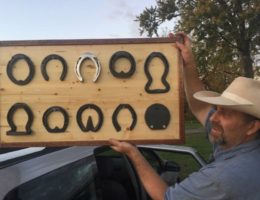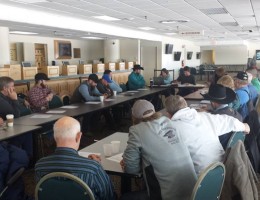Member Spotlight – Dick Harris
I started shoeing out of necessity when I was just fourteen or fifteen years old. My Father was a horseshoer, who did his own and a few neighbors, but didn’t travel. I rode an old mare about five miles to school in North English, Iowa. She needed to be shod, so I grabbed some tools, and although it wasn’t pretty, I shod her myself. We were so poor, I couldn’t go to shoeing school. Instead, I rode with Paul Hackett for two or three years. Paul was an excellent farrier and we shod mostly Saddlebreds throughout Missouri and Iowa. Once we were in Kirkwood, Missouri at the Sutton Brother’s Stable and a lady came up to Paul and asked him if we could trim her mules. Paul said we would come by when we got done with the Sutton’s. When we arrived, the lady came to the door and said the mules were in the barn. We went to the barn and there were the mules, none of which had ever been caught, let alone trimmed, and all their feet were six to eight inches long. We managed to get halters on them, drug them out of the barn, threw them down and trimmed them. It took us several hours, rather than the hour and a half we expected, and I just remember being very, very tired.
I worked at Maple Crest Hereford Ranch as Assistant Farm Manager for a few years, and it was there that I met my High School sweetheart and love of my life. Jean and I married on December 11, 1948 and we were blessed with three children; Rick Harris, Barb Rickard(Rick), and Jan Stephenson(Kevin). Rick passed away unexpectedly on March 31, 1994. He was a good guy and it was pretty hard for all of us to take, but we have been blessed with a wonderful family. We have four grandchildren; Brad Rickard(Carrie), Traci Nichols(Cody), and Karrisa and Jeremy Stephenson; and four great grandchildren; Blake and Kyle Rickard, and Parker and Leigha Jean Rose Nichols.
I don’t remember how I decided to make horseshoeing a career, but I guess it must have been when I found myself shoeing horses all day and then people bringing horses to me at night. This was back in 1944 when iron was hard to come by during the war and we had to scour the countryside to find anything that we could turn into a horseshoe. Dump rake teeth was the iron of choice when we could find it, as we could make a strong, but light shoe for the Standard bred race horses that were popular at the time. When I wasn’t shoeing, I traveled to rodeos and rode bareback broncs and bulls throughout Iowa, Missouri, Nebraska, Wisconsin, and Illinois. I rode with my friends the Mayo brothers, Roger, Don, Bob, and Paul, who a couple of which went on to become World Champions. I spent sixteen years riding and judging rodeos starting back in 1947.
My worst experience shoeing horses was one day in Grinnell, Iowa, when I was working in a barn without much room, just a very poor place to shoe. I got all the horses shod, but he still had a two year old that needed trimmed. The colt wouldn’t stand and things got out of hand. I remember grabbing on to his tail and he kicked with both feet and hit me in the hip area on the way up. It hurt pretty bad, but I finished him. For a long time, I could only walk about halfway to the barn before my back would start hurting. The only relief I would get was to lay down on my back with my head down. For weeks I would be driving along and get a “Hell” of a pain in my back. The only thing I could do was to stop the truck, get out, lay down, and put my head back until it quit.
I was inducted into the International Horseshoeing Hall of Fame in the year 2000. I feel the members of the Iowa Professional Farriers Association(IPFA) played a very important role in that award and I again want to thank everyone that was involved in helping make this honor possible. The IPFA has been very good for me. We had a lot of fun during the South English All Around Classics, roping the steer, making shoes out of rasps and baling wire, and anything else we could think of doing. I hope everyone learned a little something.
The most rewarding part of my career was happy people and good horses that knew how to stand. I don’t think I would change anything. What I like the least about shoeing horses is wet horses and muddy feet. The thing I like most about shoeing is horses that stand, don’t lean on you, and don’t move around. If everyone paid, it was fine. If they didn’t, I had to weed them out. Yes, I would still be a horseshoer. You meet a lot of people. We still hear from people we shod for long ago. I have had several special people train with me over the years and most are still in business, like Denny Beyer, Blane Thompson, Jeremy Fisher and the late Dick Partlow, just to name a few. At times, I would have as many as four other shoers working with me.
I would like to be remembered as a guy who was fair to everyone. God knows I don’t profess to know it all, but I will stand up for the farrier and the veterinarian every time until proven wrong. If I had a son or daughter who wanted to be a farrier, I would advise them to go to school and learn all they can. Pick someone that you admire and learn from them. It’s not all shortcuts and roses. Everyone always told me, “Pick a job you love, and you’ll never work a day in your life”.







Follow us